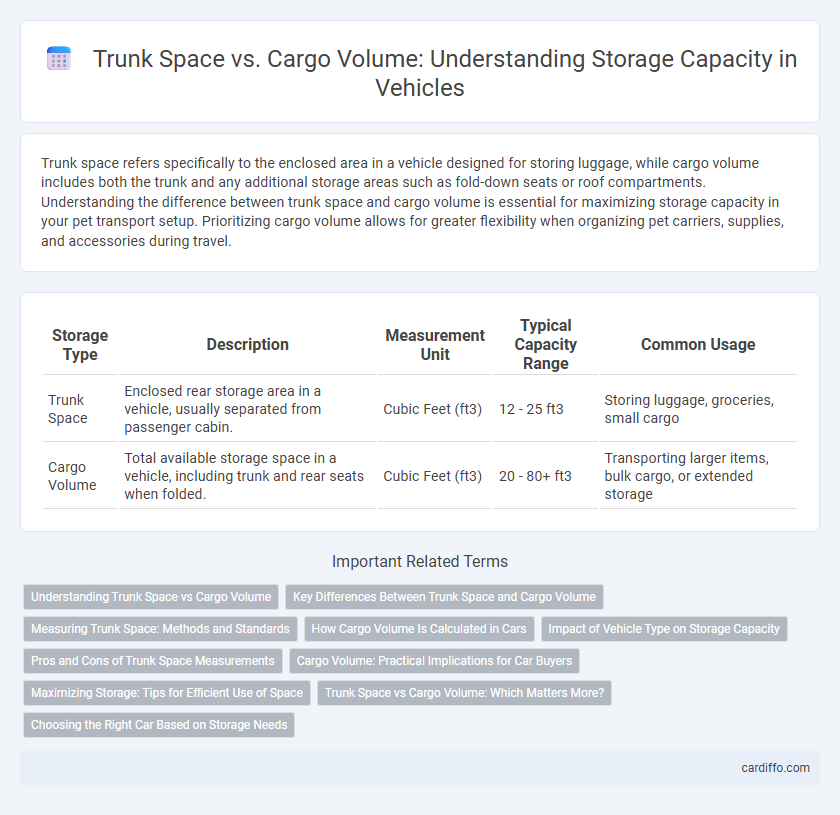Trunk space refers specifically to the enclosed area in a vehicle designed for storing luggage, while cargo volume includes both the trunk and any additional storage areas such as fold-down seats or roof compartments. Understanding the difference between trunk space and cargo volume is essential for maximizing storage capacity in your pet transport setup. Prioritizing cargo volume allows for greater flexibility when organizing pet carriers, supplies, and accessories during travel.
Table of Comparison
| Storage Type | Description | Measurement Unit | Typical Capacity Range | Common Usage |
|---|---|---|---|---|
| Trunk Space | Enclosed rear storage area in a vehicle, usually separated from passenger cabin. | Cubic Feet (ft3) | 12 - 25 ft3 | Storing luggage, groceries, small cargo |
| Cargo Volume | Total available storage space in a vehicle, including trunk and rear seats when folded. | Cubic Feet (ft3) | 20 - 80+ ft3 | Transporting larger items, bulk cargo, or extended storage |
Understanding Trunk Space vs Cargo Volume
Trunk space refers specifically to the enclosed storage area within a vehicle's rear compartment, measured in cubic feet, and is critical for everyday passenger cars. Cargo volume encompasses all available storage areas, including fold-down seats and interior compartments, providing a more comprehensive measure of a vehicle's total storage capacity. Accurate comparison of trunk space and cargo volume helps consumers select vehicles that meet their specific storage needs for luggage, groceries, or larger items.
Key Differences Between Trunk Space and Cargo Volume
Trunk space refers specifically to the enclosed storage area located at the rear of a vehicle, typically measured in cubic feet, designed for secure and weather-protected storage of luggage and smaller items. Cargo volume encompasses the total available space inside a vehicle, including the trunk, rear seats, and any additional compartments, providing a more comprehensive measurement of storage capacity. Understanding the distinction helps consumers gauge the practical use of storage for various needs, from daily commutes to large hauling requirements.
Measuring Trunk Space: Methods and Standards
Measuring trunk space involves standardized methods such as SAE J1100, which uses predefined geometrical shapes to estimate cubic capacity accurately. Cargo volume is often calculated by filling the trunk area with specific-sized blocks or balls to simulate usable space, ensuring consistency across vehicle comparisons. These standardized measurements provide reliable data for comparing storage capacity between different models and vehicle types.
How Cargo Volume Is Calculated in Cars
Cargo volume in cars is calculated by measuring the total interior space available for storage behind the front seats, including the trunk, rear seats, and any additional compartments that can be used to hold items. This measurement typically uses cubic feet or liters to account for all usable areas, excluding spaces occupied by fixed structures like the engine or passenger seats. Accurate cargo volume calculation helps consumers compare storage capacities across different vehicle models, ensuring better decision-making for transporting goods or luggage.
Impact of Vehicle Type on Storage Capacity
Vehicle type significantly impacts storage capacity, with SUVs and minivans typically offering larger trunk space and cargo volume compared to sedans and hatchbacks. Pickup trucks provide extensive cargo volume in their beds but comparatively limited enclosed trunk space, affecting security and protection from weather. Crossovers balance trunk space with flexible cargo volume through foldable rear seats, enhancing overall storage versatility for various passenger and cargo needs.
Pros and Cons of Trunk Space Measurements
Trunk space measurements provide a straightforward indication of usable storage often expressed in cubic feet, making it easier for consumers to compare vehicles. However, these measurements can be limited as they typically exclude irregularly shaped areas and fold-down seat space, potentially underrepresenting total cargo capacity. The reliance on standardized trunk space ignores practical usability and cargo flexibility, which can mislead buyers prioritizing storage versatility.
Cargo Volume: Practical Implications for Car Buyers
Cargo volume directly impacts the practical storage capacity available to car buyers, determining how much luggage, groceries, or equipment can fit comfortably inside a vehicle. Unlike trunk space, which refers specifically to the enclosed compartment typically located at the rear, cargo volume includes all usable storage areas such as fold-down seats and interior compartments. Understanding cargo volume helps buyers evaluate a car's versatility for daily use and long trips, influencing decisions based on lifestyle and storage needs.
Maximizing Storage: Tips for Efficient Use of Space
Maximizing trunk space involves understanding the difference between trunk space and cargo volume, where trunk space typically refers to the fixed storage area and cargo volume includes all available storage with seats folded down. Use stackable storage bins and vacuum-sealed bags to optimize the cubic feet of cargo volume by reducing wasted airspace. Prioritize organizing items by size and frequency of use to make the most efficient use of the available storage dimensions within your vehicle.
Trunk Space vs Cargo Volume: Which Matters More?
Trunk space refers specifically to the enclosed area behind a car's rear seats designed for storing luggage and smaller items, while cargo volume includes both trunk space and additional storage areas such as fold-down seats and roof racks, offering a broader measure of a vehicle's carrying capacity. For daily commuting and grocery runs, ample trunk space provides convenience and security, but when transporting larger or irregularly shaped items, cargo volume becomes more critical to accommodate flexibility. Understanding the distinction between trunk space and cargo volume helps consumers choose vehicles that best meet their specific storage and usability needs.
Choosing the Right Car Based on Storage Needs
Trunk space measures the dedicated rear storage compartment in a car, often limiting flexibility for larger items. Cargo volume includes all usable storage areas such as fold-down seats and cargo bays, providing a more comprehensive assessment of a vehicle's capacity. Prioritize cargo volume when choosing a car for versatile storage needs, especially if transporting bulky or irregularly shaped items frequently.
trunk space vs cargo volume Infographic

 cardiffo.com
cardiffo.com